|
Reading:
 Eaton, 288-339 Eaton, 288-339
 Richard Barnett, "Introduction" in North India Between Empires: Awadh, the Mughals, and the British, 1720-1801, 1-41 Richard Barnett, "Introduction" in North India Between Empires: Awadh, the Mughals, and the British, 1720-1801, 1-41
 Om Prakash, "The Supremacy of the East India Company, 1740-1800" in European Commercial Enterprise in Pre-colonial India, 268-314 Om Prakash, "The Supremacy of the East India Company, 1740-1800" in European Commercial Enterprise in Pre-colonial India, 268-314
Documents:
 Aurangzeb, Farewell (1707) Aurangzeb, Farewell (1707)
 Robert Clive, Letter to William Pitt regarding British policy in Bengal (1759) Robert Clive, Letter to William Pitt regarding British policy in Bengal (1759)
 East India Company Act of 1767 East India Company Act of 1767
 Robert Clive, Speech in the House of Commons on India (1772) Robert Clive, Speech in the House of Commons on India (1772)
 Warren Hastings, Letter to Court of Directors of the East India Company (1783) Warren Hastings, Letter to Court of Directors of the East India Company (1783)
 Edmund Burke, Speech in the House of Commons on India (1783) Edmund Burke, Speech in the House of Commons on India (1783)
|






